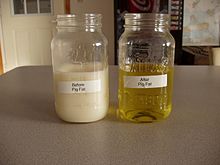Bio-Blend Fuels

Bio-Blend Fuels Inc. is a company producing bio-diesel from various materials including beef tallow and vegetable oil. They are based in Manitowoc, Wisconsin and have an annual capacity of 2.6 million US gallons. The company is notable for producing bio-diesel from pig fat recovered from commercial bacon production facilities.
History[edit]

The company was founded in 2005 by husband and wife Dan and Tracy Kaderabek. It was originally launched merely to supply the Kaderabek's boat business with cheap fuel. However, in May 2009, a new plant was opened with a capacity of 2.6 million US gallons (9,800 m3) per year which provides biodiesel direct to the pump for sale to the public.[1][2][3][4]
The company is a very small player even in terms of just the U.S market, but in terms of Wisconsin they have a significant share of the market for biodiesel. However, they are a long way behind the leading Wisconsin producer, Sanimax, who produce 20 million US gallons (76,000 m3) per year.[5]
Blends[edit]
Bio-Blend Fuels produce and sell 100% biodiesel (B100) manufactured from the raw materials by a process called transesterification. However, unblended biodiesel is problematic in that it tends to gel at a temperature of 32 °F or below. For this reason biodiesel sold for use in private vehicles is usually blended with petrodiesel, a common blend being 20% biodiesel to 80% petrodiesel (B20). A B20 blend gels at around 17 °F, a full 15 degrees below freezing and hence is much more reliable. Commercial users on the other hand, such as operators of farm vehicles, are better able to deal with the shortcomings of B100 with appropriate planning and may still wish to take advantage of the price difference. Bio-Blend Fuels are selling B100 at significantly below the national average cost of diesel. Other groups of users may wish to reach a different compromise with a different blend.[1][3][6]
For this reason, Bio-Blend Fuels have installed a patented blending system at the new facility. This is able to deliver a blend at the pump to the individual needs of the customer. Sales direct to the public are made through a separate company, American Fuel Blending Systems which also carries out the on-site blending.[2]
Raw materials[edit]

A number of sources are used in the production of biodiesel, including the more traditional vegetable oils. However, much publicity surrounded Bio-Blend's decision to source its main ingredient from pig fat. This is largely obtained from meat rendering plants who are producing cooked bacon from pork in microwave ovens. The fat is an unwanted by-product of this process.[1][3][4][6][7]
Amongst the claimed advantages of Bio-Blends biodiesel is that it has a sweeter smell than regular biodiesel. The product smells of bacon, unlike regular biodiesel, described by one reviewer, as smelling of "rancid popcorn".[4][6][7]
The company has stated that it is researching the possibility of using algae as a raw material.[6]
References[edit]
- ^ a b c Charlie Mathews, "Local couple convinced time is right for biodiesel fuel" Archived 2010-04-01 at the Wayback Machine, Herald Times Reporter, September 12, 2006.
- ^ a b Susanne Retka Schill, "Bio Blend Fuels begins Wisconsin operations", Biodiesel Magazine, May 12, 2009.
- ^ a b c Josh Morby, "Manitowoc Facility Produces Biodiesel from Pig Fat" Archived 2011-07-24 at the Wayback Machine, Wisconsin Bio Industry Alliance, posted May 21st, 2009.
- ^ a b c Elina Shatkin, "The car that runs on bacon", Los Angeles Times, May 13, 2009.
- ^ "Plant list" Archived December 9, 2009, at the Wayback Machine, Biodiesel Magazine, last modified October 6, 2009.
- ^ a b c d Charlie Mathews, "Couple helps bacon fat fuel diesel engines" Archived 2010-04-01 at the Wayback Machine, Herald Times Reporter, May 12, 2009.
- ^ a b "Bio-Blend Fuels use pig fat for biodiesel"[permanent dead link], Biodiesel and Ethanol Investing, written May 26, 2009.
